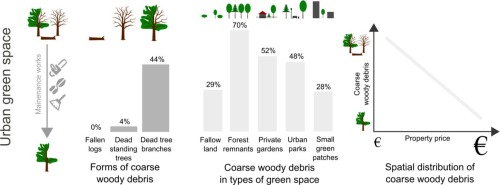当前位置:
X-MOL 学术
›
Landsc. Urban Plan.
›
论文详情
Our official English website, www.x-mol.net, welcomes your
feedback! (Note: you will need to create a separate account there.)
Dead wood resources vary across different types of urban green spaces and depend on property prices
Landscape and Urban Planning ( IF 7.9 ) Pub Date : 2020-05-01 , DOI: 10.1016/j.landurbplan.2020.103747 Arkadiusz Fröhlich , Michał Ciach
Landscape and Urban Planning ( IF 7.9 ) Pub Date : 2020-05-01 , DOI: 10.1016/j.landurbplan.2020.103747 Arkadiusz Fröhlich , Michał Ciach

|
Abstract Dead wood provides important ecosystem services and has a positive effect on biodiversity. However, urban environments have limited resources of coarse woody debris (CWD). The presence of CWD depends on both progressive tree mortality and the frequency and intensity of CWD removal for safety or aesthetic reasons, which can lead to variations in CWD occurrence. The aim of this study was to assess the variation in the quantity and quality of CWD in urban green spaces and to assess the relationship between CWD resources and management policy, ownership, economic parameters and factors accelerating tree mortality. Fallen logs, dead standing trees and dead tree branches (DTB) were surveyed on 488 sample plots selected at random in the city of Krakow (Poland). Distance to the river, coverage of impervious surfaces, environmental pollution, property prices and types of green space were used to explain the variation in CWD resources. CWD occurred on 46% of the sample plots. DTB were the most frequent form of CWD (44% of plots), while dead standing trees were rare (4%) and fallen logs absent. The prevalence of CWD was the highest in forest remnants, followed by private gardens, urban parks, fallow land and small green patches. DTB were the most abundant in the forest remnants. In both forest remnants and private gardens, the probability of CWD occurrence decreased with increasing property prices. Management policy and economy rather than factors accelerating tree mortality are suggested as shaping CWD resources in urban green spaces. The article highlights the importance of DTB as the most widespread form of CWD and forest remnants as the type of green space having the most abundant resources of CWD. Sustainable management of CWD resources within urban green spaces and environmental education are needed to conserve biodiversity and maintain ecosystem services.
中文翻译:

不同类型的城市绿地的枯木资源各不相同,并取决于房地产价格
摘要 枯木提供重要的生态系统服务,对生物多样性具有积极影响。然而,城市环境的粗木屑 (CWD) 资源有限。CWD 的存在取决于渐进的树木死亡率以及出于安全或美观原因移除 CWD 的频率和强度,这可能导致 CWD 发生的变化。本研究的目的是评估城市绿地中 CWD 数量和质量的变化,并评估 CWD 资源与管理政策、所有权、经济参数和加速树木死亡的因素之间的关系。在克拉科夫市(波兰)随机抽取的 488 个样地中,对倒下的原木、枯死的树木和枯死的树枝 (DTB) 进行了调查。与河流的距离、不透水表面的覆盖、环境污染、房地产价格和绿地类型被用来解释 CWD 资源的变化。CWD 发生在 46% 的样本地块上。DTB 是 CWD 最常见的形式(占地块的 44%),而枯死的树木很少(4%)并且没有倒下的原木。CWD 的流行在森林残余中最高,其次是私家花园、城市公园、休耕地和小绿地。DTB 是森林残余物中最丰富的。在森林遗迹和私家花园中,CWD 发生的概率随着房价的上涨而下降。建议管理政策和经济而不是加速树木死亡的因素来塑造城市绿地中的 CWD 资源。文章强调了 DTB 作为 CWD 最普遍的形式和森林残余物作为 CWD 资源最丰富的绿地类型的重要性。需要对城市绿地内的 CWD 资源进行可持续管理和环境教育,以保护生物多样性和维持生态系统服务。
更新日期:2020-05-01
中文翻译:

不同类型的城市绿地的枯木资源各不相同,并取决于房地产价格
摘要 枯木提供重要的生态系统服务,对生物多样性具有积极影响。然而,城市环境的粗木屑 (CWD) 资源有限。CWD 的存在取决于渐进的树木死亡率以及出于安全或美观原因移除 CWD 的频率和强度,这可能导致 CWD 发生的变化。本研究的目的是评估城市绿地中 CWD 数量和质量的变化,并评估 CWD 资源与管理政策、所有权、经济参数和加速树木死亡的因素之间的关系。在克拉科夫市(波兰)随机抽取的 488 个样地中,对倒下的原木、枯死的树木和枯死的树枝 (DTB) 进行了调查。与河流的距离、不透水表面的覆盖、环境污染、房地产价格和绿地类型被用来解释 CWD 资源的变化。CWD 发生在 46% 的样本地块上。DTB 是 CWD 最常见的形式(占地块的 44%),而枯死的树木很少(4%)并且没有倒下的原木。CWD 的流行在森林残余中最高,其次是私家花园、城市公园、休耕地和小绿地。DTB 是森林残余物中最丰富的。在森林遗迹和私家花园中,CWD 发生的概率随着房价的上涨而下降。建议管理政策和经济而不是加速树木死亡的因素来塑造城市绿地中的 CWD 资源。文章强调了 DTB 作为 CWD 最普遍的形式和森林残余物作为 CWD 资源最丰富的绿地类型的重要性。需要对城市绿地内的 CWD 资源进行可持续管理和环境教育,以保护生物多样性和维持生态系统服务。











































 京公网安备 11010802027423号
京公网安备 11010802027423号